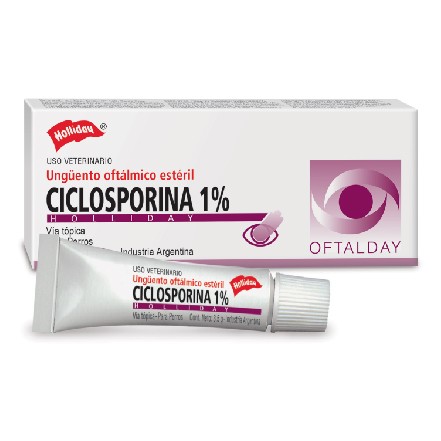Categories
- Anesthetic | Analeptic | Tranquilizer
- Anti-inflamatory
- Antibiotic
- Antimycotics
- Antiseptic Disinfectant
- Biomodulator
- Bird Medication
- Cardiological
- Dermatological
- External Antiparasitic
- Gastroenterological
- Geriatrical
- Health & Wellness
- Internal Antiparasitic
- Odontological
- Oncology Medication
- Ophthalmological
- Osteoarticular
- Otological
- Prescribed Diets
- Reproductive System
- Respiratory System
- Revitalizer
- Urinary System and Diuretics
Oftalmológicos

CICLOSPORINA 1% OFTALDAY
description
Immunomodulatory, lacrimomimetic and anti-inflammatory ophthalmic ointment .
presentation
Tube containing 3.5 g with ophthalmic applicator.
action
Immunomodulatory, lacrimomimetic and anti-inflammatory. Cyclosporine inhibits NF-kB activation, which is a nuclear factor involved in gene regulation in the immune and proinflammatory response of cytokines.
Anti-inflammatory action: it acts on the T helper cells identified in the tissues of the eye surface and tear glands, which intervene in the inflammatory response through the cytokine synthesis. The immune response suppression occurs in the eye surface tissue because these specific proinflammatory cytokines are essential to activate T helper cells, which cannot be synthetized or released as they do it normally.
indications
Indicated in the treatment of keratoconjunctivitis sicca (KCS) and chronic superficial keratitis (pannus).
Other indications: To reduce or eliminate corneal scars, Eosinophilic keratitis (cats), Plasmacytic conjunctivitis, Superficial punctate keratitis, Ulcerative blepharitis of the nasal canthus, Scleritis and episcleritis.
formula
100 g of ointment contains:
Cyclosporine A (USP) 1 g
Excipients q.s.
dosage and administration
Apply 1 cm of ophthalmic ointment on the affected eye every 12 h. Treatment duration is at the discretion of the treating veterinarian based on progress. Administer the indicated quantity directly on the cornea or in the conjunctival sac, then softly massage the eyelid for adequate product distribution. Once open, keep in the refrigerator.
contraindications
Do not use in cases of viral or fungal eye infection. Do no use in case of hypersensitivity to any of the components in the formulation.
collateral damage
It may cause irritation during the first days of treatment. If irritation persists beyond 7 days, hypersensitivity to this drug should be suspected and therapeutic options should be considered.
restrictions on use
Its use in pregnant or lactating bitches is not recommended.
Caution
If necessary, we suggest removing the exudate with non-irritant solutions before applying the ophthalmic ointment. The instillation of the ophthalmic ointment can rarely be associated with local irritation manifested by periocular reddening, eyelid spasm and excessive rubbing. Given that the eyes of dogs with KCS often show considerable inflammation, it will be hard to determine whether this local irritation is due to hypersensitivity to the ophthalmic ointment. If this ocular irritation persists for more than 7 days, hypersensitivity to a component of the ophthalmic ointment should be suspected and therapeutic options should be reevaluated.

